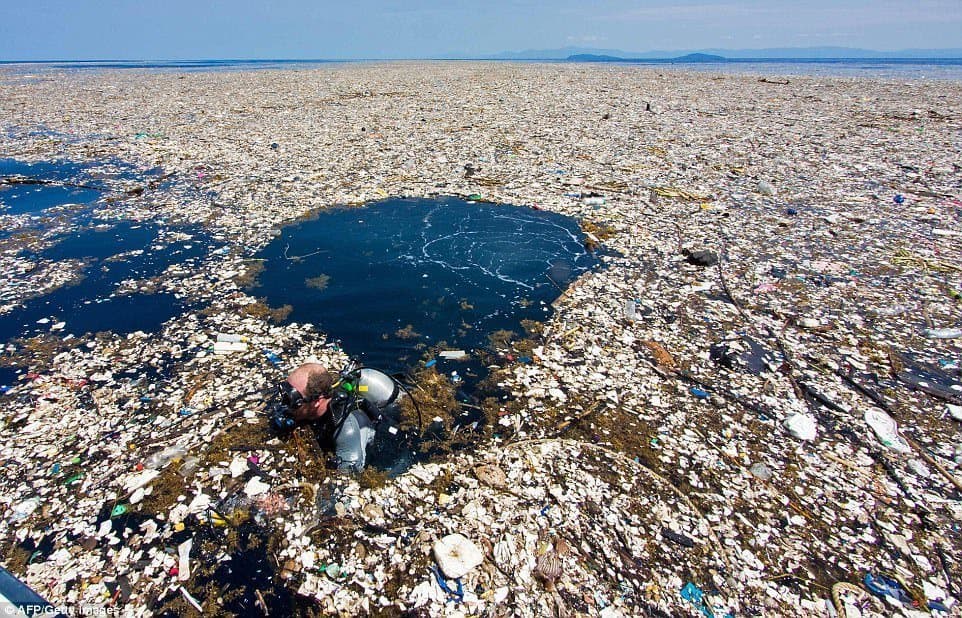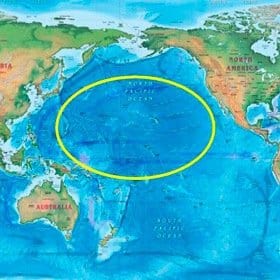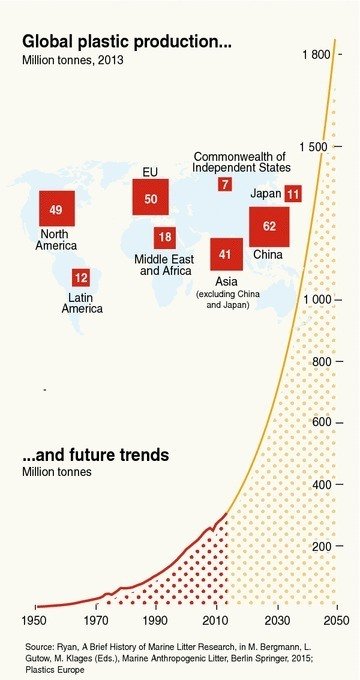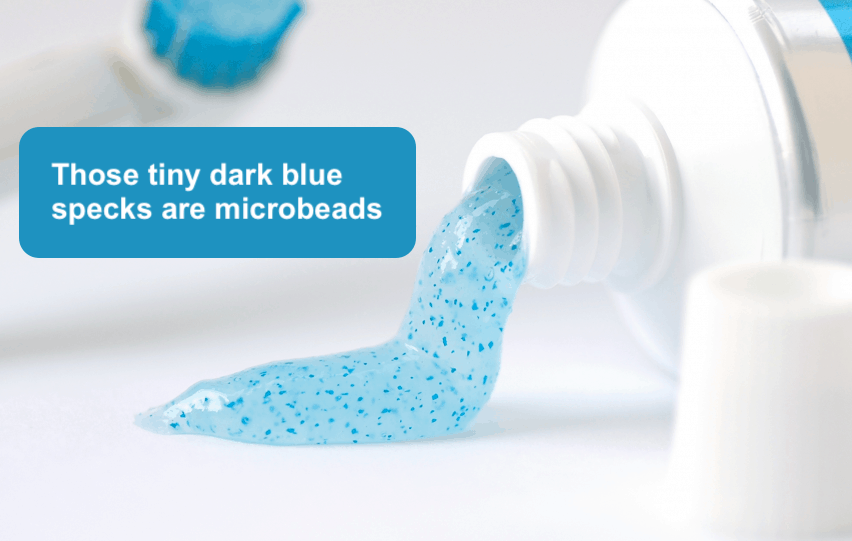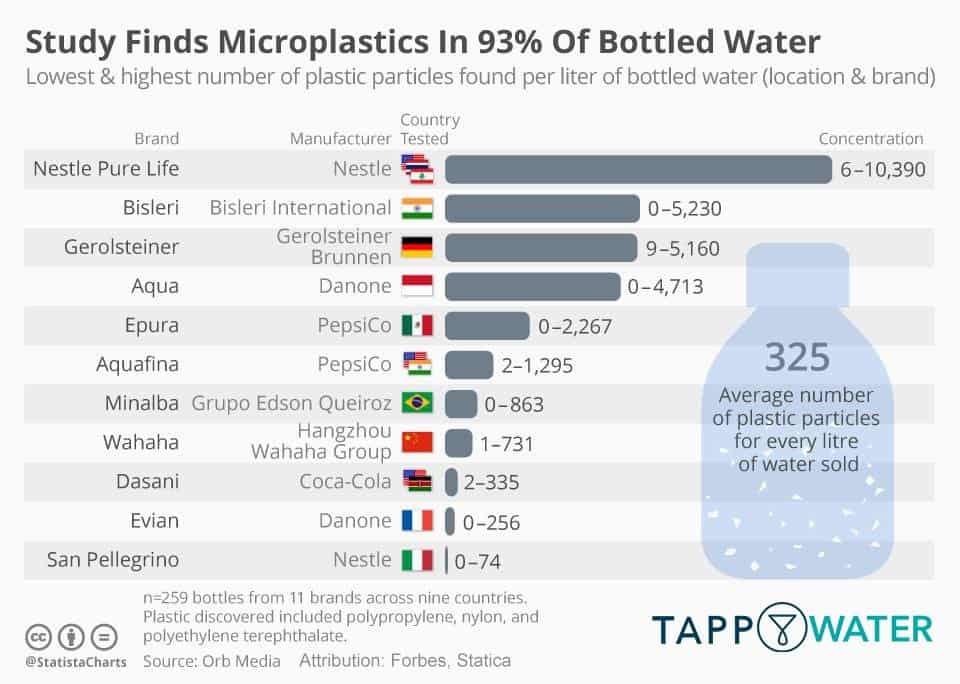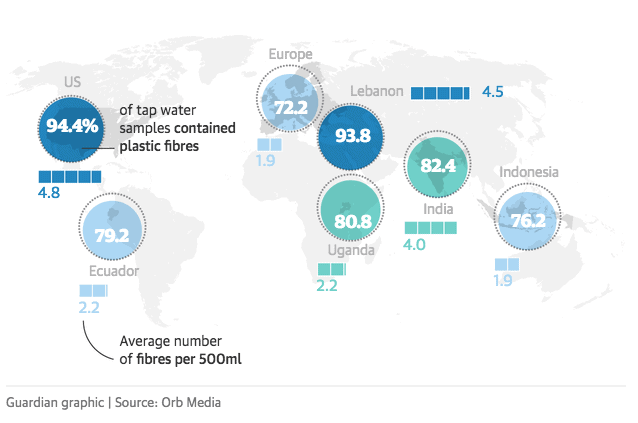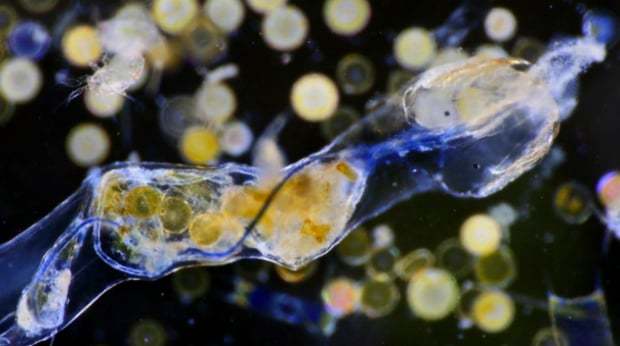How To Get Rid of Dangerous Microplastics in Salt, Water, Cosmetics — and You!

Microplastics are everywhere and they’re damaging more than just the planet. Microplastics in salt, drinking water, food, cosmetics and toothpaste mean they wind up in you. Find out what to do about it. [Scroll down to watch the video.]
Updated on April 9, 2022
About eight million metric tons of plastic that humans produce that winds up in the oceans. It degrades into tiny bits of plastic called microplastics. They’re everywhere. Microplastics in salt, drinking water, food, cosmetics and toothpaste mean that they pollute everything, including you. Find out what to do about it.
In this article, you’ll discover:
Let’s dig in…
What Are Microplastics?
Microplastics are tiny bits of plastic, typically from polyethylene plastic. They are created intentionally and unintentionally.
When microplastics are intentionally created by various health and cosmetic companies they’re called “microbeads”. Microbeads are used to replace naturally occurring exfoliates.
The unintentional creation of microplastics occur from the degradation of larger pieces of plastics into bits so small they’re not visible to the eye. Such bits measure less than 5 millimeters (0.2 inches) in diameter.
Given that this world is choking on plastic, microplastics and microcbeads are everywhere — including in you!
Why Microplastics Are Everywhere: In Salt, Water, Food — Everywhere, Including Inside of You
Scroll down to watch the video concerning microplastics in beauty products.
The reason that microplastics are ubiquitous is very simple: the world produces hundreds of millions of tons of various types of plastic every year. Most of it gets dumped on the land, rivers, lakes and oceans, where over time these plastics degrade into microscopic bits of plastic — microplastic — that gets infused into every life form that encounters it, including you.
Huge amounts of plastic waste are dumped in the environment. This plastic waste degrades into microplastics and contaminate the entire planet, from the summit of Mount Everest to the deepest oceans. Plastic is the most prevalent type of marine debris found in our ocean and Great Lakes.
Global plastic production now averages more than 300 million metric tons per year, which is a staggering increase compared to the 1.5 million metric tons produced in 1950. The quantity of plastic materials produced since 1950 has now surpassed more than nine billion metric tons, with much of this produced in the past decade. Disgustingly, more than half of all plastics ever produced have ended up as waste. The improper disposal of plastic waste poses a serious issue because some plastic products can take 500 years to decompose.
Each year eight million metric tons of plastic end up in our oceans!
That’s 10% of worldwide plastic production, equal to five grocery bags filled with plastic for every foot of coastline in the world. In 2025, the annual input is estimated to be about twice greater, or 10 bags full of plastic per foot of coastline. So the cumulative input for 2025 would be nearly 20 times the eight million metric tons estimate – 100 bags of plastic per foot of coastline in the world [1].
In the most polluted places in the ocean, the mass of plastic exceeds the amount of plankton six times over [2].
Astoundingly, microplastics make up 94% of an estimated 1.8 trillion pieces of plastic in the “Patch” [3].
What’s the “Patch”, you ask?
Well, let’s begin with two pictures:
(1) This is a picture of the Great Garbage Patch of plastic:
(2) This is a picture of where it’s located:
Apparently, the outlook is bleak. This graph projects that the total tonnage of plastics in the world’s oceans will get to 1,800 million tons by 2050:
A big contributor to the oceans plastic contamination are commercial fishing nets. Approximately 80% of fish are caught in nets. When these plastic nets get too old and become entangled, they’re often cut free from fishing boats and left to pollute the ocean, where they entangle and kill fish, whales, sea turtles and seals, and eventually break down into microplastics. For more on this, read Coty Perry’s eye-opening article, Overfishing, Conservation, Sustainability, and Farmed Fish.
So, the simple reason that all animal life — including you — is ingesting and absorbing microplastics is because we have dumped billions of metric tons of plastic into our environment. At this point, contact with micropastics is unavoidable; the best you can do is minimize exposure and work to purge it from your body, which I’ll soon address.
But first…
You use cosmetics and/or toothpaste, yes?
Then spend two minutes watching this:
Yes, by now it might sound stranger than fiction, but microplastics in the form of microbeads are used in cosmetics and body care products as a cheap additive that helps to exfoliate and sanitize.
As reported by Paleohacks.com, they can be found in lotions, sanitizers, toothpastes, and body scrubs, as well as other products. Microbeads also add color and texture to cosmetic products such as bronzer, blush, lipstick, gloss, and highlighters.
A single tube of facial scrub can contain upwards of 300,000 microbeads. If you own multiple products that contain microbeads, you could easily have more than a million in your home at any given time.
The microbeads in cosmetics and personal care products are made of different types of plastic, which have deleterious effects on human health. These are synthetic polymers, such as polyethylene, PLA (polylactide or polylactic acid), polypropylene, polystyrene, and polyethylene terephthalate.
Like many types of plastics we routinely use — such as plastic water bottles — microplastics/microbeads can have hormone-disrupting effects on your body, most notably through increasing estrogen. Overall, the disruption to hormones caused by these plastics can result in problems with reproductive hormones, thyroid, infertility, and even an increased risk of developing certain types of cancer.
Before you buy cosmetics, lotions, body scrubs — even toothpaste — read the labels and look up the ingredients on EWG.org
Microplastics in salt
A widely reported on story of late concerns the microplastics in salt. Many articles have summarized a National Geographic article, Microplastics found in 90 percent of table salt and a study entitled, Microplastics in Seafood and the Implications for Human Health.
The National Geo article reports that microplastics were found in 90% of the table salt brands sampled worldwide.
Adults ingest 2,000 pieces of plastic in table salt on average each year [4]!
Sea salt is made from the evaporation of seawater, rather than being extracted from sedimentary deposits. It’s used for culinary purposes, as well as in cosmetics. Some people believe it offers a fuller taste than regular salt due to its coarser texture and different rate of dissolution. Sea salt is common in many parts of the world and is growing in popularity.
Of 39 salt brands tested, 36 had microplastics in them, according to a new analysis by researchers in South Korea and Greenpeace East Asia. Using prior salt studies, this new effort is the first of its scale to look at the geographical spread of microplastics in table salt and their correlation to where plastic pollution is found in the environment.
Those 39 brands — which were not named — operate in one or more of 21 countries in Europe, North and South America, Africa, and Asia. Of these, 28 were sea salts, nine were rock salts, and two were lake salts.
Only three of the samples were microplastics-free:
- a refined sea salt from Taiwan,
- a refined rock salt from China, and
- an unrefined sea salt in France produced by solar evaporation [5].
Two other salts that may be free of microplastics are:
- Ava Jane’s Kitchen, called Colima Sea Salt. I haven’t tried it, but apparently it’s a coarse, unrefined, crunchy, moist sea salt that contains all the trace minerals our body needs.
- Korean Jugyeom bamboo salt.
Dave Asprey, the Founder of supplement company Bulletproof, wrote on his personal blog that Jugyeom, or purple bamboo salt, is sea salt that has been roasted in a clay-lined bamboo case at temperatures as hot as approximately 2,700 degrees Fahrenheit. This extreme heat is said to remove impurities from the salt for medicinal use, and to melt any microplastics that may be in it. I wonder, however, where that melted plastic goes?
Note: Mixed Reviews re China
Salt made in countries in Asia had by far the most microplastics of all the samples, which correlates with where plastic most often enters the ocean. Nine of the top 10 sea salts sampled with the highest amount of microplastics came from Asian countries [6].
Microplastics in your tap and bottled water
Microplastics in salt largely come from sea water, but there’s plenty in the water you drink as well no matter where you live.
Tests show billions of people globally are drinking water contaminated by plastic particles, with 83% of samples found to be polluted.
Scores of tap water samples from more than a dozen nations were analyzed by scientists for an investigation by Orb Media, who shared the findings with the Guardian. Overall, 83% of water samples were contaminated with plastic fibers.
The US had the highest contamination rate, at 94%, with plastic fibers found in tap water sampled at sites including Congress buildings, the US Environmental Protection Agency’s headquarters and Trump Tower in New York. Lebanon and India had the next highest rates.
European nations including the UK, Germany and France had the lowest contamination rate, but at 72%, this should give little comfort to those living in Europe.
The average number of fibers found in each 500ml sample ranged from 4.8 in the US to 1.9 in Europe.
Tap Water Is Contaminated by Microplastic Throughout the World
Microplastics in tap and bottled water are not regulated, so it is up to you to remove microplastics and other contaminants from your drinking water, which I’ll address below in “How You Can Purge Microplastics From Your Body”.
Microplastics in food
We’ve all seen those sad pictures and videos of various marine animals gulping down chunks of plastic or being entwined in it. That stuff is visible. What’s largely invisible is the microplastics ingested by plankton and on up the food chain, eventually to us.
This planktonic arrow worm, Sagitta setosa, has eaten a blue plastic fiberf about 3mm long. Plankton support the entire marine food chain.
A Healthline.com article examining microplastics in food reports that:
- The most common food source of microplastics is seafood, given that microplastics are common in seawater where they’re consumed by plankton, fish and other marine organisms — even in those of deep-sea organisms, suggesting that microplastics are affecting even the most remote species.
- Studies have shown that certain fish mistake plastic for food, which can lead to toxic chemicals accumulating inside fish liver.
- Mussels and oysters are at a higher risk of microplastic contamination than most other species. A recent study found that mussels and oysters harvested for human consumption had 0.36–0.47 particles of microplastic per gram, meaning that shellfish consumers could ingest up to 11,000 particles of microplastic per year.
- One recent study examined 15 different brands of sea salt and found up to 273 microplastic particles per pound (600 particles per kilogram) of salt.
- Other studies have found up to 300 microplastic fibers per pound (660 fibers per kilogram) of honey and up to about 109 microplastic fragments per quart (109 fragments per liter) of beer.
Microplastics in your body
On April 6, 2022, The Guardian reported:
- Microplastics have been discovered deep in the lungs of people for the first time, in nearly all the samples analyzed.
- The most common microplastic particles were polypropylene, used in plastic packaging and pipes; and PET (Polyethylene Terephthalate), used in plastic bottles.
- Microplastics were detected in human blood for the first time in March, showing the particles can travel around the body, and may lodge in organs.
- A 2021 study in Brazil on autopsy samples found microplastics in 13 of the 20 people analyzed. Polyethylene, used in plastic bags, was one of the most common particles.
- Microplastics have been found in the placentas of pregnant women, and in pregnant rats they pass rapidly through the lungs into the hearts, brains and other organs of the fetuses.
How Microplastics Affect Your Health
Clearly, humans are exposed to plastics of all kinds; microplastic particles are found in our seafood and water supply, in the air we breathe and in the dust in our home. How much damage microparticles in marine, freshwater and land ecosystems has on human health still needs to be determined, for although a number of studies have shown there are microplastics and microbeads and plastic-derived chemicals of all kinds inside our body, the damage they do us is uncertain.
Researchers are concerned as microplastics cause damage to human cells in the laboratory, and air pollution particles are already known to enter the body and cause millions of early deaths a year.
A US study of lung cancer patients in 1998 found plastic and plant fibers (such as cotton) in more than 100 samples. In cancerous tissue, 97% of samples contained the fibers and in non-cancerous samples, 83% were contaminated.
A recent review assessed cancer risk and concluded:
More detailed research on how micro- and nanoplastics affect the structures and processes of the human body, and whether and how they can transform cells and induce carcinogenesis, is urgently needed, particularly in light of the exponential increase in plastic production.
An article published by the Functional Medicine Institute reviewed seven ways plastic phthalates (a type of chemical used to make plastic flexible) can damage your body:
1: Phthalates damage the chemistry of fatty acids most importantly, the fatty acid, DHA (docosahexaenoic acid). This is the fundamental chemistry necessary for making every cell lining or membrane. These fatty acids are the foundation for brain health including memory and recall.
2: Phthalates can create a zinc deficiency which will compromise the metabolism of vitamins A and B-6. In turn this could lead to conditions such as indigestion, depression, heart disease, cancer, diabetes, and accelerated aging.
3: Phthalates has been found to be responsible for damaging the pancreas leading to diabetes, insulin resistance and metabolic syndrome.
4: Phthalates has been found to lower sulfation. This means that you are no longer able to effectively detoxify like you should. This in turn can lead to a whole host of health challenges.
5: Phthalates damage hormone function, especially thyroid and testosterone.
6: Phthalates can poison the peroxisomes needed for the control of the chemistry of cholesterol. They can cause high cholesterol while at the same time keep cholesterol from forming the “happy hormones” (neurotransmitters) of the brain.
7: Phthalates can damage the body’s ability to make catalase. Catalase is absolutely essential for devouring up the hydrogen peroxide that cancer cells make to allow them to metastasize or wildly spread throughout the body. Lack of catalase is a reason why many cancers briefly seem to be in remission after treatments, only to resurface months or years later with lethal consequences.
Back to that Healthline article, which makes the following assertions:
- Phthalates have been shown to increase the growth of breast cancer cells. However, this research was carried out in a petri dish, so the results can’t be generalized to humans.
- When fed to mice, the microplastics accumulated in the liver, kidneys and intestines, and increased levels of oxidative stress molecules in the liver. They also increased the level of a molecule that may be toxic to the brain
- Microparticles including microplastics have been shown to pass from the intestines into the blood and potentially into other organs.
- Plastics have also been found in humans. One study found that plastic fibers were present in 87% of the human lungs studied. The researchers proposed this may be due to microplastics present in the air.
- Some studies have shown that microplastics in the air may cause lung cells to produce inflammatory chemicals. However, this has only been shown in test-tube studies.
- Bisphenol A (BPA) is one of the best studied chemicals found in plastic. It is usually found in plastic packaging or food storage containers and can leak out into food.
- Some evidence has shown that BPA can interfere with reproductive hormones, especially in women.
(References in support of these statements may be found here.)
Plastics (or the chemical name, phthalates) are now considered the number one pollutant in the human body. They make products flexible, durable, and these chemicals are also in items you would not consider to be plastics, like pesticides, detergents, cosmetics, medications, or your shampoo. They are found everywhere. It is difficult to completely avoid them.
You can live in the most pristine place on planet earth and still find animals polluted with plastics.
Let’s take a look at what you can do about it.
Further Reading:
- My article, How 212 Toxins In Your Body Make You Sick and Fat
- Tap Water: The Dangers of Microplastics In Drinking Water
- Research study: Microplastics in Seafood and the Implications for Human Health
How Can You Purge Microplastics From Your Body
Undoubtedly, plastic-derived chemicals and a long list of heavy metals — such as mercury, aluminum and lead — bioaccumulate in our bodies, and over time can potentially present us with a toxic burden that can sicken us and contribute to chronic diseases.
To purge microplastics from your body you must:
- Determine if you have dangerous levels of them in your body (your “toxic load”);
- Reduce your exposure to them; and
- Work to improve the ability of your detoxification pathways to eliminate them from your body.
Test your microplastic toxic load
Some people are fast metabolizers and quickly eliminate any exposure to plastics, and/or many environmental toxins. This is somewhat rare for those of us who live where we’re exposed to various pollutants, or have lifestyles that increase the toxic load sufficient to overwhelm our body’s natural detoxification capabilities, such as drinking from plastic water bottles, or using table salt, among the many other sources of microplastics I’ve already covered.
The only way to know for sure your microplastic toxic burden is to get a test, such as the Environmental Pollutants Profile Urine Test offered by Life Extension Foundation.
Here’s a sample report: Enviornmental Pollutants Profile
Go here to learn more about the test.
Reduce your exposure to microplastics
It’s a simple idea — don’t get microplastics into your body to begin with. The folks at Organic Lifestyle Magazine have a good list to consider.
- Keep your home clean, and vacuum regularly
- Filter tap water and then boil it (Read How To Reduce Microplastics In Your Water)
- Always avoid artificial fragrances
- Stay away from warm or hot plastics, don’t even breathe near them
- Avoid canned foods
- Avoid conventional personal care products like shampoos, soaps, moisturizers, makeup (Read labels and look up ingredients on EWG.org)
- Avoid conventional and big-ag produce (pesticides and herbicides have plastic residues)
- Cook your own foods using whole-food ingredients
- Stop using plastic straws, even in restaurants
- Purchase food, like cereal, pasta, and rice from bulk bins and fill a reusable bag or container
- Use paper or your own reusable shopping bags, bulk goods bags, and bring your own mesh produce bags (FYI: I suspect that many paper bags contain BPA and BPS)
- No more chewing gum, it’s made of plastic
- Buy boxes and glass instead of plastic bottles when possible
- Use a reusable bottle or mug for your beverages or coffee and soda refills (but you don’t drink that crap, do you?)
- Boycott any restaurant that still uses styrofoam – Why is that still a thing?
- Use matches or invest in a refillable metal lighter – avoid the plastic disposable ones
- Eat real, whole foods – fresh foods equates to less packaging and less previous plastic contact
- Don’t use plasticware ever, bring your own if need be
- Use cloth diapers – disposable diapers are extremely toxic to the environment and your baby
- Make your own cleaning products
- Pack your lunch in glass containers and reusable bags.
- Use a razor with replaceable blades instead of a disposable razor
- Find other disposal products that can be replaced by their non-disposable counterparts
- Minimize seafood, particularly shell fish
- Avoid cheap supplements and be wary of sports supplements
To the “avoid” list, I’d like to add:
- Trade in whatever salt you’re using to salt made in France, Korea, or Colima Sea Salt.
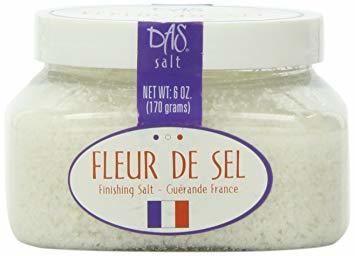
- Filter your tap water with filtration systems that filter particles as small as 5 millimeters, such TAPP and Clearly Filtered (the one I use) brands.
Purge the Plastic-derived Chemicals Inside Your Body
I’ve written a lot about detoxification and suggest you scroll down the list of articles and read whichever ones grab your interest.
Here are thee samples:
- Why You Must Detox All The Time
- How 212 Toxins In Your Body Make You Sick and Fat
- How to Detoxify Yourself and Why You Absolutely Must
Unfortunately, scientists don’t know yet how to excrete microplastics from our body; nonetheless, the following foods and supplements can detoxify pesticides, chemicals and heavy metals, so they might help with microplastics to some degree:
- Regularly consume Calcium D-Glucarate containing vegetables, such cabbage, broccoli, brussels sprouts, cauliflower, radishes, watercress, turnips, collard greens and kale. Or take Calcium-D-Glucarate in supplement form, as well as IndolPlex.
- Having 2 or more servings of Brassica or cruciferous vegetables a day revs up the detoxification of plastics. These include cabbage, broccoli, brussels sprouts, cauliflower, radishes, mizuna, watercress, arugula, turnips, collard greens, kale, rutabaga, and more.
- Globe artichoke contain flavonoids that upregulates the Phase I detoxification pathway.
- Berberine to increase endogenous antioxidants (those produced by the body).
- Milk thistle contains the active compound silymarin which restores depelted Glutathione (GSH) to aid Phase II detoxification processes and help protect the liver.
- Activated charcoal: A tried and true detox supplement, the small pockets in carbon charcoal pick up and store anything from metals to cellular debris and synthetic substances like mircroplastics before leaving your body, useful huh?
- Folate: This B vitamin protects DNA, and enhances cellular repair, and although it does not directly detoxify mircoplastics, it can aid in keeping your cells safe from genetic damage caused by toxins like BPA and other bisphenols that sometimes leach out from them.
- Tea: Green, black, white, all have diuretic properties which helps your body get rid of excess fluids, not to mention the powerful anti-oxidant punch that they all have in store. (I love Gynostemma (AMPK Activator green tea.)
- Get the mircoplastic phthalates out with an Far Infrared Sauna. Here are two articles to get you started:
Your Takeaway On Microplastics
Remember (and do) these four things to substantially reduce your microplastics burden:
- Due to the prevalence of microplastics in salt, water, food and various cosmetics and toothpaste, you have them in your body. Over time, they — in combination to the rest of the toxic load from heavy metals and other chemicals — can potentially create a health hazard.
- Identify where microplastics might lurk in the things you consume and find alternatives. In the case of tap water, filter it. In the case of salt, find salt that’s not contaminated with microplastics, such as French salt.
- Eat vegetables rich in calcium d-glucarate, such cabbage, broccoli, brussels sprouts, cauliflower, radishes, watercress, turnips, collard greens and kale.
- Regularly take the detoxifying supplements listed above and drink lots of that filtered water.
Before you go, take a look at How To Detoxify Yourself and Why You Absolutely Must.
Last Updated on May 25, 2024 by Joe Garma


